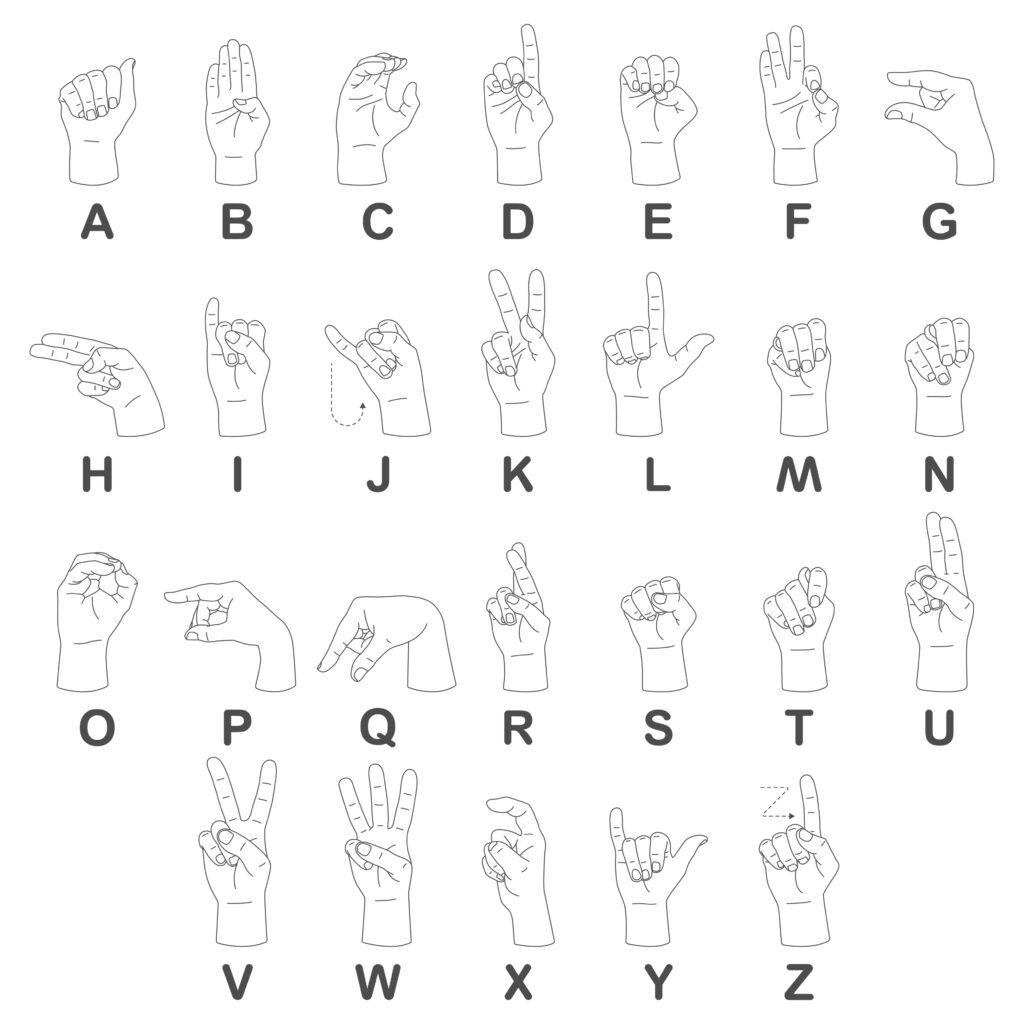By Sahara Al-Madi
This month we want to spotlight American Sign Language and express gratitude for the hard of hearing and deaf community.
The World Health Organization reports that over 1.5 billion people globally live with hearing loss. This number could rise to over 2.5 billion by 2050. This condition is common and has existed within the lives of many such as the esteemed Ludwig van Beethoven, Hellen Keller, and Thomas Edison. Sign language is an important and essential language which contains varieties from different regions of the world. American Sign Language has a particularly interesting history that we will explore through its linguistic process and the deaf community.
Hearing loss is defined by the WHO as not being able to hear thresholds of 20dB or better in both ears. It can be mild, moderate, moderately severe, severe or profound, and can affect one or both ears. The hard of hearing and deaf community include those who require signing as a primary way to communicate, those who learn to sign in order to communicate with a loved one, teachers of sign language, translators and interpreters of sign language, etc.
American Sign Language is a language completely separate and distinct from English. It contains all the fundamental features of language, with its own rules for pronunciation, word formation, and word order. Dr. Carol Padden, a professor in the Department of Communication at the University of California, San Diego, wrote her thesis on how she observed three major classes of verbs in ASL: plain, inflecting and spatial. Padden discusses how the previous analyses of ASL verbs have noted that verbs differ markedly with respect to which morphology can be added to the verb stem. However, no clear criteria have been offered for distinguishing between inflecting and certain forms of spatial verbs which have highly similar morphology. The present analysis distinguishes between person and number agreement morphology. This can be added only to inflecting verbs, and other morphological forms such as manner and location. Her study proposes that the verb agreement rule for inflecting verbs is best stated in terms of grammatical relations.
Dr. James Woodward, an Adjunct Professor in the Department of Linguistics at UH Mānoa, explains that ASL differs from vocally produced languages in the ways their words are produced and perceived. English words are produced by actions within the vocal tract that result in sounds perceived through audition. Signs, the words of a sign language, are produced by the actions of the hands, arms, torso, face, and head that produce signals perceived visually. There is a misconception that signs are patterned after the vocally produced language that is spoken. This is not the case as it can be observed through the following example of the same sentence in English and in Sign language.
- If you copy words from an encyclopedia
IF SOAP WORD FROM ENCYCLOPEDIA
that means you are copying someone else’s words.
THAT THIS/SHOW SOAP SOME OTHER WORD
The lowercase words in (1) are transcriptions of the teacher’s spoken English. The uppercase English glosses appearing underneath the spoken words represent the signs produced by the teacher as she spoke.

It is a common misconception for new signers learning ASL that the language is all in the hands when it is also in the face! According to the National Association of the Deaf, it is possible to sign without using facial expressions or body movements, but doing so may cause a misunderstanding and appear unnatural to native signers.
Please watch the following informational video which conveys this example
The exact origin of ASL is not clear, but some suggest that it arose more than 200 years ago from the intermixing of local sign languages and French Sign Language (LSF, or Langue des Signes Française). Woodward argues that ASL is the result of creolization of French Sign Language, brought to the United States by Laurent Clerc in 1816, with several indigenous sign languages that existed in some signing communities in the country. An example of this is Plains Indian Sign Language (PISL or “hand talk”) which developed as a way for Native Americans of different tribes to communicate with each other across the barrier of different languages. It was once prevalent but now a very endangered language. In 2019, Eastern Shoshone elder and Wyoming Humanities board member, Willie LeClair, proposed a project to record him using hand talk to preserve its use and contemporary format and present it in a way that would encourage people of all ages to try to learn to use it.
American Sign Language is a language with fascinating linguistic structure with a wonderful community. There is much to learn about its morphology and syntax which is exciting for us to discover. I am grateful for organizations which provide resources for the deaf community and information which educates us on the importance of learning this language. I hope that this month’s article may have sparked your interest. I would love to expand my research and write further articles on deaf culture as well as international sign language.
Works Cited
Liddell, Scott K. Grammar, gesture, and meaning in American Sign Language. Cambridge University Press, 2003.
Woodward James, Simple Historical basis of American Sign Language. 1978. pp. 333–48.
Additional Resources
There are many organizations that support the deaf community through resources in accessible courses for parents with children who are hard of hearing, job training and guidance, scholarships for training interpreters, etc. The American Sign Language Teacher Association is a national association dedicated to the improvement and expansion of the teaching of ASL and Deaf Studies at all levels of instruction. ASLTA is an individual membership organization of more than 1,000 ASL and Deaf Studies educators, from elementary school through graduate education, and all ASL instructors are welcome to join.
A Sign language resource for parents can be found through the National Association for the Deaf
The National Deaf Center shares information, networks, and strategies to improve continuing education and training for deaf people. Their mission is to improve outcomes for deaf people in continuing education and training. They offer online courses, online gaming tools for youth, data reports, research summaries, evidence-based resources, webinars, and more. Their products and services are deaf-centered, evidence-based, and developed in response to community needs.
The Georgia Department of Education recently published an exemplar unit and lesson plans for WL educators for all levels K-12, including immersion in both French and Spanish. There are resources for ASL as well! You can find them linked on their website here.
Links to explore
Georgia Department of Education’s World Languages and Global / Workforce Initiatives
https://www.nad.org/resources/american-sign-language/learning-american-sign-language/
American Sign Language Teachers Association
Resources

